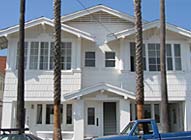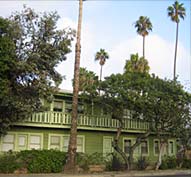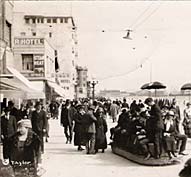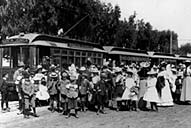




137, 141, 145 & 147 Bay St.
Year Built: approx. 1900


Bay Street Craftsman Cluster,
approx. 1900

Bay Street Craftsman Cluster -
green building

Ocean Park, CA - Taylor, 1918

Santa Monica electric car - 1896
The growth of Ocean Park can be traced directly to the trolleyway. According to a City of Santa Monica staff report, when the Pacific Electric Street Railway was linked between Los Angeles and Ocean Park in 1896, summer vacationers and weekend fun seekers were able to travel from the city to the coast in only 40 minutes.
The Pico Line of the Los Angeles County Railroad secured this right of way to Santa Monica in June 1888, when John P. Jones and Arcadia Bandini de Baker donated a fifty foot right of way through the 30,000 acre Rancho San Vicente y Santa Monica.
According to the Los Angeles Times, the first passenger train reached Santa Monica in January 1889. Seaside fun abounded in 1891 when entertainment entrepreneur Abbot Kinney and his partner Francis Ryan bought controlling interest in the Ocean Park Casino and the surrounding tract of land. They built a beach resort called Ocean Park. Ocean Park Pier in the center of their resort at Pier Avenue opened in 1898.
On July 4th 1905, Kinney official expanded his coastal entertainment empire to include Venice of America, a recreation of Venice, Italy on the shores of the Pacific. Electric trolley cars with frequent service from downtown Los Angeles and nearby Santa Monica facilitated the process.
An established resort area, Ocean Park became its own incorporated community from 1904-1907.
The City report notes that due in part to new restrictions on property leasing, a considerable number of the early beach cottages were replaced by more substantial houses suitable for year-round living.
Socioeconomic factors of the time dictated a need for small-scale transient housing. Notice the efficiency of design in each unit of this Craftsman complex. Classic style can be found in these two-story, multi-family dwellings in their low-pitched, gabled roofs, exposed beams and rafters; efficiency is featured in the rollout beds, built-in storage areas, tripartite windows and sleeping porches.
According to UCLA's Venice Timeline, when the Bay Street Craftsman Cluster was built; there was a tremendous amount of development happening around the Santa Monica coast.
* Construction started next to the Kinney Pier on Thompson's Scenic
Railroad. The mountainous train ride became renowned for its tunnel, which
gave couples a chance for a quick embrace.
* The Kinney Pier was widened, and rides and attractions were added, along
with a Japanese Tea House, and the Ocean Inn restaurant.
* Alexander Fraser commenced construction on Fraser's Million Dollar Amusement
Pier in Ocean Park. Promotion boasted that Fraser's Million Dollar Amusement
Pier would be the largest amusement pier in the world - 1250 feet long
and 300 feet wide.
Authorities note The Bay Cluster exemplifies typical Ocean Park development
during the earliest portion of the twentieth century. Unlike many single-family,
upscale residences designed for individuals, these well-crafted buildings
were designed for common people who worked locally. The Bay Craftsman
Cluster is one of the last extant examples of multi-family Craftsman buildings
in the immediate vicinity, and serves as a striking reminder of the cultural
and social patterns of early twentieth century Santa Monicans.